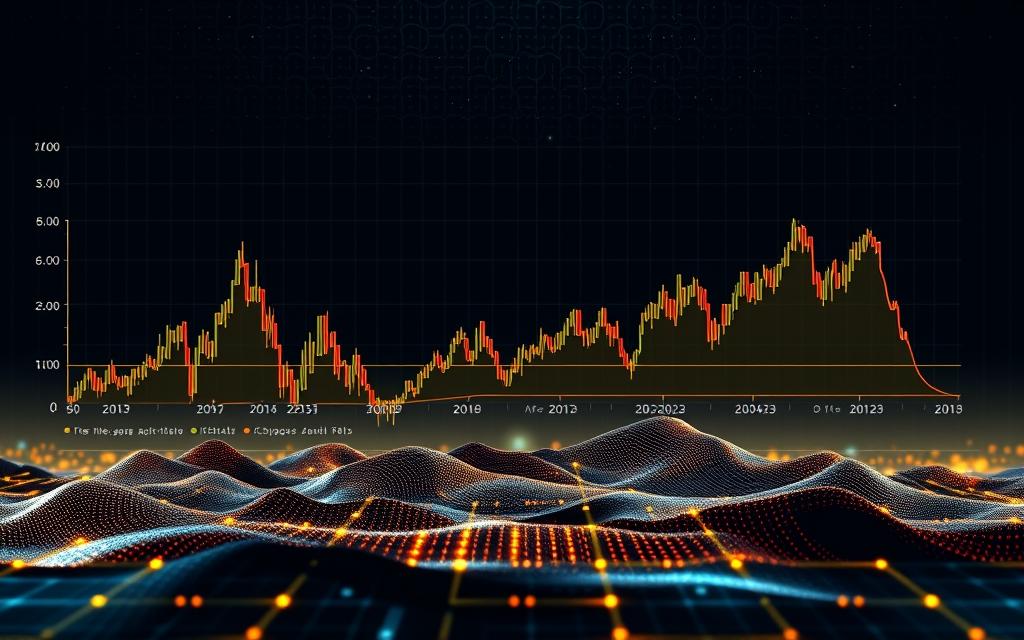Table of Contents
The digital asset market has seen recent turbulence, with major tokens like Bitcoin and Ethereum dipping in value. Bitcoin slipped below $102K, while Ethereum hovered around $2,530. Mid-sized investors, however, continue accumulating, signaling long-term confidence.
Market sentiment remains mixed. The Crypto Fear & Greed Index shows overbought conditions at 74, suggesting caution. Yet, institutional interest grows—Coinbase’s upcoming S&P 500 inclusion could bring billions in fresh capital.
Technical levels reveal key support zones. Bitcoin’s $100K mark acts as a psychological barrier, with $90K-$92K as a potential safety net. Analysts remain optimistic, with some predicting major rallies by 2025.
Macro factors, like U.S. inflation data and China’s tech performance, influence price swings. While short-term volatility persists, the broader trend hints at resilience. Investors watch closely for updates that could shift momentum.
Current State of the Cryptocurrency Market
Recent volatility has shaken the digital asset space, with top tokens experiencing notable drops. Bitcoin briefly topped $105K before retreating, while Ethereum and altcoins like Solana faced steeper declines. This pullback reflects mixed sentiment amid macroeconomic shifts.
Recent Price Declines Across Major Cryptocurrencies
Over the past week, losses varied widely among assets. Bitcoin dipped 1.92%, holding above $100K support. Ethereum fell 2.48%, and altcoins like Cardano (-6.10%) underperformed due to thinner liquidity.
| Asset | 7-Day Change | Key Support Level |
|---|---|---|
| Bitcoin (BTC) | -1.92% | $100K |
| Ethereum (ETH) | -2.48% | $2,500 |
| Solana (SOL) | -5.58% | $140 |
Key Events Influencing Market Sentiment
The U.S.-China trade deal briefly lifted risk assets, but April’s CPI data reignited inflation fears. Meanwhile, Coinbase’s upcoming S&P 500 listing could funnel $9B+ into the market, offsetting retail caution.
Mid-sized investors accumulated 83K BTC last month, signaling confidence. Whale activity tracked by Santiment suggests accumulation near current price levels, a potential floor for recovery.
Factors Behind the Recent Crypto Downturn
Market corrections have cooled recent gains, with digital assets facing pressure from multiple fronts. Three key factors drive the current slump: profit-taking after a rally, macroeconomic headwinds, and regulatory ambiguity.

Profit-Taking After a Strong Rally
Historical data shows 10-30% pullbacks are common after all-time highs. The recent 5-6% dip aligns with this pattern. Traders locked in gains, especially in altcoins like Solana, which saw sharper declines due to thinner liquidity.
“Profit-taking is healthy—it resets overbought conditions,” notes a CoinMarketCap analyst. Bitcoin’s resilience near $100K suggests long-term holders remain unfazed.
Macroeconomic Pressures and Inflation Concerns
The Fed’s 5.25-5.5% interest rates and April’s sticky CPI data spooked investors. Bitcoin’s correlation with the Nasdaq highlights sensitivity to rate hikes. China’s renewed trading restrictions added to global risk-off sentiment.
Regulatory Uncertainty and Its Impact
Ongoing SEC lawsuits against major exchanges, like Coinbase, create volatility. Meanwhile, Europe’s MiCA rules impose strict reserve requirements on stablecoin issuers, squeezing short-term liquidity.
Institutional outflows, tracked via Grayscale’s ETF, reflect caution. Yet, mid-sized investors continue accumulating—a sign of confidence in eventual market recovery.
Market Sentiment and Investor Behavior
Investor psychology plays a crucial role in shaping digital asset trends. The interplay between fear and greed often dictates short-term price swings, while long-term holders focus on fundamentals.
Crypto Fear & Greed Index Analysis
The Fear & Greed Index currently sits at 74, signaling greed territory. This metric weighs volatility, social media buzz, and dominance trends to gauge sentiment.
Compared to Q1 2025’s euphoric 89 reading, today’s levels suggest cautious optimism. Analysts note that sustained scores above 70 often precede corrections.
Institutional vs. Retail Investor Activity
Data reveals a growing divide between institutional and retail investors. Mid-tier wallets (10-10K BTC) added 83K BTC last month, while retail exits spiked stablecoin ratios.
Coinbase’s institutional volume surged 47% quarterly, contrasting with Robinhood’s retail-driven dips. “Whales accumulate during pullbacks,” notes a Santiment report.
CME Bitcoin futures open interest hints at institutional hedging, while Binance volumes reflect retail’s volatility sensitivity.
Institutional Capital and Its Role in Recovery
Institutional players are reshaping the digital asset landscape with strategic moves. Their growing involvement hints at long-term confidence, even during price dips. Data reveals mid-sized investors and ETFs are driving this shift.

Mid-Sized Bitcoin Holders Accumulating
Wallets holding 10-10K BTC added 83K Bitcoin last month, per Glassnode. This group now controls 12% of circulating supply—a record high. Their accumulation pace outstrips daily mining output by 3:1.
| Wallet Size (BTC) | 30-Day Net Flow | % of Supply |
|---|---|---|
| 10-10K | +83K | 12% |
| 1K-10K | +42K | 8% |
| Whales (10K+) | -15K | 22% |
“Mid-tier investors often buy during pullbacks,” says a Chainalysis report. Custody solutions from BNY Mellon and State Street simplify institutional entry.
Coinbase’s S&P 500 Inclusion and Its Implications
Coinbase joins the S&P 500 on June 24, mirroring Tesla’s 2020 debut. Analysts project $9B+ in passive inflows from index funds. COIN’s weighting could rival Airbnb’s, attracting finance giants.
BlackRock’s IBIT ETF now holds 300K+ BTC—5% of its gold ETF’s AUM. Combined with 12 other approved products, ETF flows offset retail outflows. Pension funds are testing 1-3% crypto exposure limits.
The market recovery hinges on this institutional adoption. As capital flows into regulated vehicles like ETFs, volatility may ease. Macro trends and funds deployment will shape the next phase.
Technical Analysis: Signs of Support or Further Decline?
Technical indicators reveal crucial insights into Bitcoin’s next potential move. Chart patterns and volume trends highlight key levels that could dictate short-term price action. Traders watch these signals closely amid ongoing volatility.

Bitcoin’s Key Support Levels
Bitcoin holds critical support near $100K, a psychological barrier. The $90K-$92K zone aligns with the 200-day moving average, a historical rebound point. Below this, the Volume Profile Visible Range (VPVR) shows liquidity clusters at $88K.
Bollinger Bands on weekly charts signal contraction, often preceding breakout moves. “$100K acts as a magnet for both buyers and sellers,” says analyst Paul Howard. Liquidation heatmaps from Bybit suggest dense sell orders above $105K.
Ethereum and Altcoin Performance
Ethereum struggles below $2.7K resistance despite the Shanghai upgrade boosting staking flows. Solana’s 5.58% drop to $169.38 reflects weaker trading volumes versus Bitcoin.
| Asset | Key Level | Technical Signal |
|---|---|---|
| Ethereum (ETH) | $2,500 support | Ichimoku cloud resistance |
| Solana (SOL) | $160-$165 zone | Relative Strength Index (RSI) oversold |
| Cardano (ADA) | $0.45 pivot | Declining volume profile |
Altcoin/BTC pairs show underperformance, suggesting capital rotation into Bitcoin. Analysts note that sustained market recovery requires broader participation beyond large-cap assets.
Historical Patterns: Lessons from Past Crypto Cycles
Analyzing past Bitcoin cycles reveals critical patterns that shape future price movements. The 2017 and 2021 bull runs, lasting 16 and 14 months respectively, show how halving events and investor sentiment drive market trends. Today’s metrics suggest similar growth trajectories, but with unique factors at play.

Comparing 2025 to Previous Bull and Bear Markets
The 2025 rally mirrors past cycles in duration but diverges in institutional participation. ETFs now funnel $9B+ into Bitcoin, akin to gold’s adoption phase in the 2000s. The MVRV ratio, currently at 2.1, aligns with mid-cycle levels—not yet euphoric like 2017’s peak of 3.8.
Key differences include:
- Investors now hold longer (average 155 days vs. 90 days in 2021).
- NUPL metrics show 45% unrealized profits—below historical tops (>60%).
- Miner revenue post-halving remains stable, with difficulty adjustments lagging by 8%.
The Role of Bitcoin Halving Events
Halvings reduce supply inflation, historically triggering bull runs. The 2028 event will cut daily issuance to 450 BTC, similar to 2020’s impact. PlanB’s floor model predicts $100K as a baseline, citing stock-to-flow deviations.
| Halving Year | Days to Peak | Price Increase |
|---|---|---|
| 2016 | 518 | 2,800% |
| 2020 | 546 | 700% |
“Post-halving rallies follow a predictable timeline,” notes a Glassnode report. Current ETF inflows could accelerate this cycle, shortening the 518-day average to peak.
Macroeconomic Factors Influencing Crypto’s Future
Macroeconomic forces increasingly dictate the trajectory of digital assets, blending traditional finance with emerging markets. From Fed rate hikes to geopolitical tensions, these factors create ripple effects across all asset classes.
U.S. Inflation and Interest Rate Trends
April’s CPI data hit 3.1% YoY, keeping pressure on the Fed to maintain 5.25-5.5% rates. Higher-for-longer interest policies strengthen the dollar, inversely impacting Bitcoin’s valuation. “The DXY-BTC correlation remains -0.82,” notes a JPMorgan report.
Analysts scrutinize the Fed’s 2025 dot plot for clues. Stagflation risks loom if inflation persists alongside slowing GDP growth. Merrill Lynch surveys show 68% of institutions now hedge with digital assets.
Global Economic Conditions and Risk Appetite
China’s 5.3% GDP growth contrasts with Europe’s recession fears. BRICS nations challenging dollar dominance could reshape market liquidity. Ray Dalio’s debt cycle analysis warns of volatility spikes in transitional periods.
Sharpe ratios favor Bitcoin over bonds (1.2 vs. 0.4), attracting capital. Yet, geopolitical instability—like U.S.-China tech decoupling—adds uncertainty. The economic landscape remains fragmented, demanding agile strategies.
Will Crypto Recover? Expert Predictions and Data
Analysts are divided on digital assets’ near-term trajectory, with bullish long-term forecasts contrasting short-term caution. While technical charts signal volatility, fundamental models project exponential growth by 2030.
Short-Term vs. Long-Term Recovery Scenarios
Technical analysts highlight Bitcoin’s $100K support as critical. A breakdown below this level could trigger a 15-20% correction. However, on-chain metrics like the RHODL ratio suggest accumulation by long-term holders.
Fundamental analysts focus on adoption. Michael Saylor’s corporate treasury thesis and ETF inflows could offset selling pressure. “Every 1% of gold’s $13T market cap shifting to Bitcoin implies a $200K price,” notes a Standard Chartered report.
High-Profile Price Predictions for 2025-2030
Institutions project staggering gains, but timelines vary. ARK Invest’s base case of $1.2M per Bitcoin by 2030 assumes mainstream adoption. Meanwhile, Finder’s panel averages $161K for 2025, citing halving-driven scarcity.
| Source | Prediction | Key Driver |
|---|---|---|
| Standard Chartered | $200K (2025) | Gold market share |
| ARK Invest | $1.2M (2030) | Institutional adoption |
| Finder Panel | $161K (2025) | Halving cycle |
Metcalfe’s Law—which ties network value to user growth—supports bull cases. GitHub developer activity and Lightning Network upgrades hint at expanding utility. Yet macro factors like Fed policy remain wildcards.
The Role of Innovation and Adoption in Recovery
Global payment giants like Visa and PayPal are embracing stablecoins, signaling broader adoption. This shift highlights how blockchain is evolving beyond speculation into practical finance solutions. Two forces drive this transition: cutting-edge technology and institutional validation.
DeFi and Blockchain Advancements
Layer-2 networks like Arbitrum and Optimism now host $12B in total value locked (TVL), up 40% quarterly. These scaling solutions reduce fees and speed up contracts, making DeFi accessible.
Ethereum’s Pectra upgrade, slated for late 2025, will enhance smart contract flexibility. Meanwhile, AI projects like Fetch.ai automate trading strategies, blending technology with decentralized protocols.
| Innovation | Impact | Key Metric |
|---|---|---|
| Real-World Assets (RWAs) | Tokenized bonds hit $1.2B | Ondo Finance leads |
| DeFi Insurance | Coverage up 200% YoY | Nexus Mutual |
Mainstream Adoption and Institutional Interest
Visa processes $10B+ in stablecoin settlements monthly, while PayPal’s PYUSD reaches $500M in market cap. These milestones reflect growing trust in blockchain-based payments.
BlackRock’s BUIDL fund, with $400M AUM, tokenizes treasury assets. Fidelity’s Bitcoin 401(k) offerings further bridge traditional and digital finance. As global crypto activity surges, institutions anchor the next phase of adoption.
Potential Catalysts for the Next Bull Run
The next major surge in digital assets could hinge on two powerful drivers: ETF expansion and regulatory breakthroughs. These factors may unlock institutional capital and stabilize the market, setting the stage for sustained growth.
Bitcoin ETFs and Altcoin ETFs
Spot Bitcoin ETFs now hold over 800K BTC, with BlackRock’s IBIT leading inflows. Grayscale’s conversion slashed premiums, making Bitcoin more accessible. “ETFs bridge traditional finance and blockchain,” says a Fidelity analyst.
VanEck’s Solana ETF filing signals growing altcoin interest. Approval could mirror Bitcoin’s post-ETF rally. Hong Kong’s crypto ETFs already attracted $200M in two weeks.
| ETF Type | Assets Under Management | Key Player |
|---|---|---|
| Spot Bitcoin | $40B+ | BlackRock |
| Futures (ETH) | $8B | ProShares |
| Altcoin (Proposed) | N/A | VanEck |
Regulatory Clarity and Government Initiatives
The U.S. Crypto Strategic Reserve proposal aims to stabilize markets during volatility. Meanwhile, Europe’s MiCA rules face a 300-application backlog, delaying compliance.
SAB 121 repeal efforts gained bipartisan support, potentially easing custody rules. Coinbase’s Basel III compliance sets a benchmark for regulatory trust. Adoption hinges on these frameworks.
“Clear rules attract institutional funds—without them, growth stalls.”
Lobbying expenditures hit $20M in Q1 2025, reflecting urgency. As policies evolve, they could fuel the next bull cycle.
Risks That Could Delay or Derail Recovery
Regulatory hurdles and erratic trading conditions threaten to prolong the current downturn. Key factors—from legal battles to thin liquidity—could stall progress. Investors must weigh these risks against long-term potential.
Regulatory Crackdowns and Legal Challenges
The SEC’s lawsuit against Coinbase continues, mirroring Binance’s $4.3B settlement precedent. Stablecoin audits, like Tether’s reserves scrutiny, add to regulatory pressures. FATF’s Travel Rule complicates cross-border transactions, straining exchange compliance.
CFTC enforcement actions surged 30% YTD, targeting unregistered derivatives. “Clear rules are missing—this creates uncertainty,” notes a Bloomberg Law report. Geopolitical tensions, like U.S.-China tech bans, exacerbate fragmentation.
Market Liquidity and Volatility Concerns
Exchange Proof-of-Reserves (PoR) audits reveal gaps, with some platforms holding market. Derivatives leverage ratios hit 25x on unregulated platforms, amplifying volatility.
- Liquidity crunches: Stablecoin reserves dropped 12% since April.
- Energy debates: Proof-of-Work mining faces EU carbon taxes.
- Security flaws: Bridge hacks drained $1.8B in 2025 alone.
These risks demand caution. Yet, institutional tools like BlackRock’s security-focused ETFs may mitigate some threats.
Strategies for Investors During Market Uncertainty
Navigating market uncertainty requires proven strategies to protect capital. Historical data shows that disciplined approaches outperform emotional decisions during downturns. Investors can leverage two key tactics: dollar-cost averaging and focusing on high-quality assets.
Dollar-Cost Averaging (DCA) in a Volatile Market
DCA involves investing fixed amounts at regular intervals, reducing the impact of volatility. Studies show it beats lump-sum investing 70% of the time during corrections. For example, $500 monthly Bitcoin purchases over 12 months often yield better entry prices than a single $6,000 investment.
| Strategy | Avg. Return (2020–2025) | Risk Level |
|---|---|---|
| DCA (Monthly) | +110% | Low |
| Lump Sum | +85% | High |
“DCA smooths out price swings,” explains Fidelity’s 2025 report. Rebalancing quarterly improves Sharpe ratios by 0.3–0.5. CME options data reveals institutions use DCA to hedge against downside risks.
Focusing on High-Quality Assets
Bitcoin (54% dominance) and Ethereum (17%) exhibit stronger resilience than altcoins. Grayscale’s research highlights three traits of premium assets:
- High liquidity (top 10 by volume)
- Institutional custody support
- Clear regulatory compliance
Cold storage adoption rose 22% in 2025, boosting security. Staking ETH yields 4.2% annually—outpacing Treasury bonds. Investors prioritizing quality over hype often see smoother portfolio growth.
Conclusion: Navigating the Path to Crypto Recovery
Historical trends and current data suggest a resilient path forward for digital assets. The market mirrors past cycle patterns, with institutional accumulation near key support levels. Mid-tier investors continue buying, signaling long-term confidence.
Short-term volatility persists, but adoption milestones—like ETF inflows and regulatory progress—hint at sustained growth. Bitcoin’s store-of-value narrative strengthens as traditional finance embraces blockchain.
For portfolios, focus on high-liquidity assets and dollar-cost averaging. The 2025-2030 outlook remains bullish, driven by scarcity and institutional demand. Patience and strategy will define success.
FAQ
What factors are driving the recent downturn in cryptocurrency prices?
Profit-taking after strong rallies, inflation concerns, and regulatory uncertainty have contributed to recent declines. Investors are adjusting positions amid shifting macroeconomic conditions.
How does market sentiment impact potential recovery?
The Crypto Fear & Greed Index shows shifting emotions, while institutional accumulation suggests long-term confidence despite short-term volatility.
Are institutions still investing during this market phase?
A> Yes. Mid-sized Bitcoin holders continue accumulating, and events like Coinbase’s S&P 500 inclusion signal growing mainstream acceptance.
What technical levels are traders watching for Bitcoin?
A> Key support zones between ,000-,000 are critical. Breaking these could trigger further declines, while holding may indicate stabilization.
How do past cycles suggest future performance?
A> Historical patterns show post-halving rallies typically occur 12-18 months later, suggesting potential upward momentum building toward 2025.
What macroeconomic trends could influence prices?
A> U.S. interest rate decisions and global inflation trends remain pivotal. Easing monetary policy often correlates with improved risk-asset performance.
Which innovations could drive the next bull run?
A> Advancements in DeFi protocols, layer-2 scaling solutions, and real-world asset tokenization are creating new utility and investment opportunities.
What risks could prolong the current market conditions?
A> Aggressive regulatory actions or liquidity crunches may delay recovery. However, institutional participation helps mitigate extreme volatility.
How should investors approach this market phase?
A> Dollar-cost averaging into high-conviction assets like Bitcoin and Ethereum allows participation while managing short-term uncertainty.









